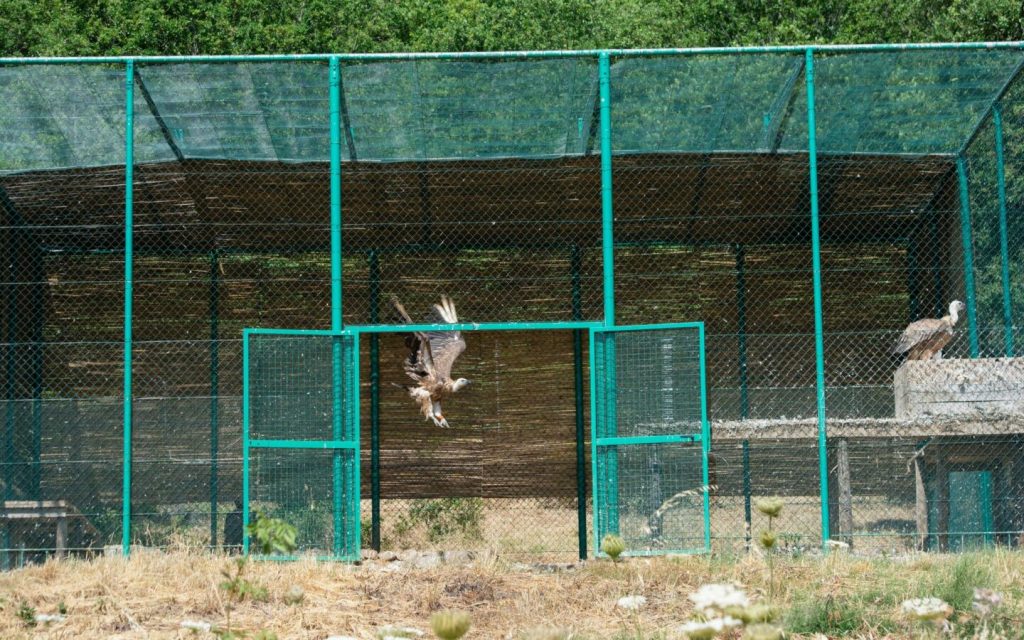In a recently published article, researchers analysed the home range stability and survival of 38 Griffon Vultures (Gyps fulvus) that have been translocated to Sardinia and released following different strategies. The study sheds light on the need to monitor post-release movements, to understand the adaptability and behaviour of released individuals and make informed decisions in future reintroduction efforts.

Translocating Griffon Vultures to strengthen the Sardinian Griffon Vulture population
Until the late 1940s, Griffon Vultures were a common sight in Sardinia. Dispersed across the island with an estimated population of 800-1200 individuals, after the Second World War, the population reduced drastically, confining the last breeding colony to the north-western area of the island. In 2013, there were only 130 individuals left! As the last autochthonous colony of the species in Italy, conservation measures started in 2015 with the Life Under Griffon Wings to boost the locally endangered population and secure a future for Griffon Vultures in Sardinia. Over 60 Griffon Vultures were translocated from Spain, Holland and other countries and released following three strategies.


Soft or hard release strategies?
Hard release involves the direct and immediate release without an acclimatisation period, and it is mainly used with vultures that have been rehabilitated in Wildlife Rescue Centres. The soft release strategy foresees a temporary period of enclosure in acclimatisation aviaries, which can be short (around three months) or long (15 months). Authors analysed the spatial behaviour and mortality of 38 Griffon Vultures released between 2016 and 2021 in a common study area: 10 individuals that had been recovered from the wild, rehabilitated and subject to a hard release, 21 were released after a short acclimatisation period and s7 released after spending 14 months in the acclimatisation aviary. Before the release in Sardinia, each Griffon Vulture was fitted with a GPS transmitter, which provided information about their movements and dispersion.


Soft release strategies proved more effective in survival rates and home range stability
According to the authors, soft release strategies seem to have various potential advantages. In the acclimatisation enclosures, Griffon Vultures can get familiarised with their surrounding environment and “develop partial cognitive maps, an important component of spatial orientation”. In addition, as gregarious species, individuals can socialise with conspecifics and create bonds that could help facilitate their integration into social groups upon release.
“The number of individuals that reached sexual maturity was higher (71.4%) in long-acclimatised griffons than in short-acclimatized ones (40%) or in griffons that were hard released (28.6%). Soft release with a long acclimatisation period seems to be the most successful method to ensure stable home ranges and the survival of griffon vultures.”
Nonetheless, authors suggest hard release strategies can be effective as complementary measures, as they can be essential in educating and informing the general public.

Continued efforts to strengthen the locally endangered Griffon Vulture population in Sardinia
LIFE Safe for Vultures is a new project co-financed by the EU’s LIFE Programme, which builds on the work of the successful LIFE Under Griffon Wings, with the ultimate objective for Griffon Vultures to regain their historical ranges and distribution areas from the central-eastern part of Sardinia to the south and at the same time promote the long-term survival of the species on the island.


The project team is working on expanding the network of farm feeding stations, creating several anti-poison dog units to tackle wildlife poisoning, establishing an additional feeding station in the south of the island, restocking the population by importing 40 additional Griffon Vultures and reducing the threat of collision and electrocution with energy infrastructures. Earlier this year, 12 Griffon Vultures imported from Spanish recovery centres arrived in Sardinia and are currently in the acclimatisation aviary in Villasalto. The University of Sassari leads the project in collaboration with Agenzia Regionale Forestas, Sardegna Corpo Forestale, E-Distribuzione and the Vulture Conservation Foundation.

Source: Insights on the best release strategy from post-release movements and mortality patterns in an avian scavenger (2023). Ilaria Fozzi, Rudy Brogi, Silvia Cavazza, Roberta Chirichella, Davide De Rosa, Mauro Aresu,J acopo Cerri, Marco Apollonio, Fiammetta Berlinguer. https://doi.org/10.1016/j.isci.2023.106699



